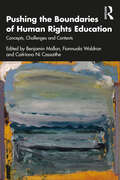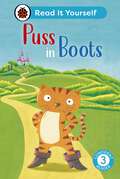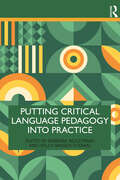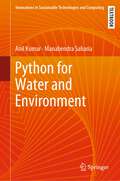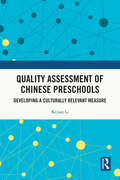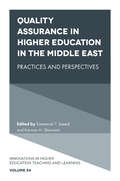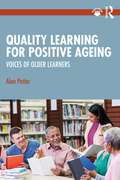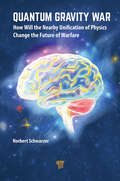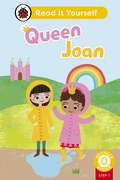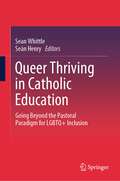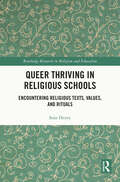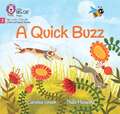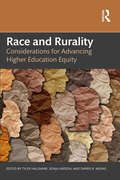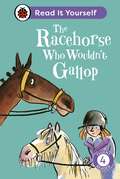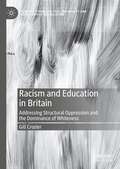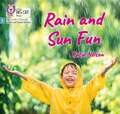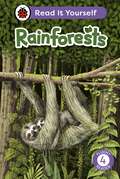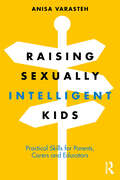- Table View
- List View
Pushing the Boundaries of Human Rights Education: Concepts, Challenges and Contexts
by Benjamin Mallon Fionnuala Waldron Caitríona Ní CassaitheThis book pushes the theoretical boundaries of human rights education, engaging with complex questions of climate-related injustices, re-imagining education through a decolonising lens, and problematising the relationship between rights and responsibilities. It presents international studies of HRE in varied contexts (e.g. Uganda, Japan, Ireland) to explore the views and experiences of children who identify as human rights defenders, initial teachers’ understandings of concepts such as teacher agency in conflict-affected settings, and the barriers to children’s political agency. The book also highlights HRE in practice including participatory research with very young children as co-researchers and realising rights through play pedagogies, creative writing approaches and picturebooks. An HRE lens is also brought to bear on emerging subjects such as relationships and sexuality education and well-being. Aimed at educators, researchers and practitioners, and engaging with a range of concepts, contexts and contemporary challenges, this book offers new insights into HRE, particularly in the context of issues relating to children’s rights education and participation.
Puss in Boots: Read It Yourself - Level 3 Confident Reader (Read It Yourself)
by LadybirdBased on the classic fairy tale. When a miller's son is left a cat by his father, he is shocked to find that Puss in Boots can talk - and not only that, Puss has a plan for helping the miller's son find happiness.Puss in Boots is from Confident Reader Level 3 and is perfect for more confident readers aged from 6+ who can read simple stories with help.Each book has been carefully checked by educational and subject consultants and includes comprehension puzzles, book band information, and tips for helping children with their reading.With five levels to take children from first phonics to fluent reading and a wide range of different stories and topics for every interest, Read It Yourself helps children build their confidence and begin reading for pleasure.
Putting Critical Language Pedagogy into Practice
by Barbara Muszyńska Holly Hansen-ThomasPutting Critical Language Pedagogy into Practice explores the practice of language teaching through the lens of critical pedagogy, reflexivity, and the importance of reflexivity for teacher development. It also shows how these reflexive practices can contribute to more inclusivity and decolonization of the curriculum. A range of experts argue persuasively for epistemological reflexivity in practice and demonstrate how to implement this critical thinking into daily instructional practice. Each chapter is structured around three themes in order to help readers connect challenging theoretical ideas into day to day teaching practice: Reflection – the author’s story and issue of concern; Epistemic Reflexivity – personal epistemologies reflecting on the social conditions influencing the theory underpinning that author’s practices; Resolved action – how the epistemic reflexivity leads to purposeful decision-making enacted in classroom contexts. Original, thoughtful and challenging, this text is fascinating and instructional reading for language education advanced students, researchers and practitioners. The idea for this book emerged during the Fulbright scholarship at Texas Woman’s University out of the mutual research interests of the editors.
Putting Critical Language Pedagogy into Practice
Putting Critical Language Pedagogy into Practice explores the practice of language teaching through the lens of critical pedagogy, reflexivity, and the importance of reflexivity for teacher development. It also shows how these reflexive practices can contribute to more inclusivity and decolonization of the curriculum. A range of experts argue persuasively for epistemological reflexivity in practice and demonstrate how to implement this critical thinking into daily instructional practice. Each chapter is structured around three themes in order to help readers connect challenging theoretical ideas into day to day teaching practice: Reflection – the author’s story and issue of concern; Epistemic Reflexivity – personal epistemologies reflecting on the social conditions influencing the theory underpinning that author’s practices; Resolved action – how the epistemic reflexivity leads to purposeful decision-making enacted in classroom contexts. Original, thoughtful and challenging, this text is fascinating and instructional reading for language education advanced students, researchers and practitioners. The idea for this book emerged during the Fulbright scholarship at Texas Woman’s University out of the mutual research interests of the editors.
Python for Water and Environment (Innovations in Sustainable Technologies and Computing)
by Anil Kumar Manabendra SahariaThis textbook delves into the practical applications of surface and groundwater hydrology, as well as the environment. The Part I, "Practical Python for a Water and Environment Professional," guides readers through setting up a scientific computing environment and conducting exploratory data analysis and visualization using reproducible workflows. The Part II, "Statistical Modeling in Hydrology," covers regression models, time series analysis, and common hypothesis testing. The Part III, "Surface and Subsurface Water," illustrates the use of Python in understanding key concepts related to seepage, groundwater, and surface water flows. Lastly, the Part IV, "Environmental Applications," demonstrates the application of Python in the study of various contaminant transport phenomena.
Quality Assessment of Chinese Preschools: Developing a Culturally Relevant Measure
by Kejian LiThis book presents the development of the Chinese Early Childhood Environment Rating Scale (CECERS), a culturally appropriate tool for assessing the quality of Chinese preschools.It provides insights into the developmental profile and pedagogical characteristics of Chinese preschools, which have been the main type of children's services in China over the past three decades. The conceptual framework of CECERS is based on cultural contexts and refers to ECERS, an international quality assessment tool for early childhood education (ECE), and combines the essential elements of ECE quality (e.g., teacher-child interactions) with additional components tailored to the situation of Chinese preschools (e.g., group educational activities). A series of studies involving over 200 preschools and 500 classrooms were conducted to ensure the validity and reliability of the CECERS in different areas of China. The content of CECERS has been continuously adapted according to the results of these verification studies. The author also discusses issues related to improving the quality of Chinese preschools and proposes relevant policy recommendations.The book will be an essential read to students and scholars of educational theory and Chinese studies. It will also serve as an interesting reference for cross-cultural scholars in the field of ECE research.
Quality Assessment of Chinese Preschools: Developing a Culturally Relevant Measure
by Kejian LiThis book presents the development of the Chinese Early Childhood Environment Rating Scale (CECERS), a culturally appropriate tool for assessing the quality of Chinese preschools.It provides insights into the developmental profile and pedagogical characteristics of Chinese preschools, which have been the main type of children's services in China over the past three decades. The conceptual framework of CECERS is based on cultural contexts and refers to ECERS, an international quality assessment tool for early childhood education (ECE), and combines the essential elements of ECE quality (e.g., teacher-child interactions) with additional components tailored to the situation of Chinese preschools (e.g., group educational activities). A series of studies involving over 200 preschools and 500 classrooms were conducted to ensure the validity and reliability of the CECERS in different areas of China. The content of CECERS has been continuously adapted according to the results of these verification studies. The author also discusses issues related to improving the quality of Chinese preschools and proposes relevant policy recommendations.The book will be an essential read to students and scholars of educational theory and Chinese studies. It will also serve as an interesting reference for cross-cultural scholars in the field of ECE research.
Quality Assurance in Higher Education in the Middle East: Practices and Perspectives (Innovations in Higher Education Teaching and Learning #54)
by Sameerah T. Saeed and Karwan H. SherwaniAs Middle Eastern countries strive to develop and achieve excellence across their higher education systems, meeting and exceeding international standards, such as quality assurance and accreditation, have become vital targets for higher education institutions in the region. Featuring case studies from Egypt, Iraq, Lebanon, Saudi Arabia, and United Arab Emirates, chapters highlight institutional arrangements designed to prioritise quality assurance and the challenges faced in these countries’ quality-seeking experience. Offering critical perspectives and recommendations to guide future academic leaders, chapters also provide ways to ensure better practices and assist in the development of the quality assurance process. An essential resource for institutional leaders across the Middle East, as well as those invested in the development of higher education in the region, Quality Assurance in Higher Education in the Middle East acts as a unique contribution for propelling the progress of higher education in the Middle East.
Quality Assurance in Higher Education in the Middle East: Practices and Perspectives (Innovations in Higher Education Teaching and Learning #54)
by Sameerah T. Saeed Karwan H. SherwaniAs Middle Eastern countries strive to develop and achieve excellence across their higher education systems, meeting and exceeding international standards, such as quality assurance and accreditation, have become vital targets for higher education institutions in the region. Featuring case studies from Egypt, Iraq, Lebanon, Saudi Arabia, and United Arab Emirates, chapters highlight institutional arrangements designed to prioritise quality assurance and the challenges faced in these countries’ quality-seeking experience. Offering critical perspectives and recommendations to guide future academic leaders, chapters also provide ways to ensure better practices and assist in the development of the quality assurance process. An essential resource for institutional leaders across the Middle East, as well as those invested in the development of higher education in the region, Quality Assurance in Higher Education in the Middle East acts as a unique contribution for propelling the progress of higher education in the Middle East.
Quality Learning for Positive Ageing: Voices of Older Learners
by Alan PotterQuality Learning for Positive Ageing explores the views of older adult learners to understand the factors that contribute to ‘quality’ in later-life learning and how these relate to wellbeing, positive ageing, and gaining protection against cognitive decline.Through capturing and considering the viewpoints of learners, facilitators and learning organisations, the author outlines the specific characteristics of quality that they associate with informal learning and how it can be enhanced through the adoption of simple strategies. Key topics covered include the implications of an increasing ageing population and barriers to older people learning as well as the cognitive, mental wellbeing, health, and social benefits of learning in later life. Illustrated throughout with vignettes of real later-life learners, this thought-provoking text unpicks how learners can maximise the benefits of learning in later life for themselves, how tutors can create learning opportunities that embody the characteristics of quality for them, and how providers can offer an environment that simply allows quality learning to flourish.This accessible and comprehensive text will be of great interest to researchers of gerontology and ageing, educational gerontology, adult education, and lifelong learning as well as those engaged in dementia research.
Quality Learning for Positive Ageing: Voices of Older Learners
by Alan PotterQuality Learning for Positive Ageing explores the views of older adult learners to understand the factors that contribute to ‘quality’ in later-life learning and how these relate to wellbeing, positive ageing, and gaining protection against cognitive decline.Through capturing and considering the viewpoints of learners, facilitators and learning organisations, the author outlines the specific characteristics of quality that they associate with informal learning and how it can be enhanced through the adoption of simple strategies. Key topics covered include the implications of an increasing ageing population and barriers to older people learning as well as the cognitive, mental wellbeing, health, and social benefits of learning in later life. Illustrated throughout with vignettes of real later-life learners, this thought-provoking text unpicks how learners can maximise the benefits of learning in later life for themselves, how tutors can create learning opportunities that embody the characteristics of quality for them, and how providers can offer an environment that simply allows quality learning to flourish.This accessible and comprehensive text will be of great interest to researchers of gerontology and ageing, educational gerontology, adult education, and lifelong learning as well as those engaged in dementia research.
Quantum Gravity War: How Will the Nearby Unification of Physics Change the Future of Warfare
by Norbert SchwarzerImagine a civilization with a technology so powerful that a single push of the “wrong” button could destroy this very entire civilization. As the consideration of future warfare requires the inclusion of a unified physics, we have to deal with complex concepts of Quantum Theory and General Theory of Relativity. The two have to be brought together before we are able to deal with the matter of future warfare technology in a satisfactory manner. That such a “Theory of Everything” or “Theory of Quantum Gravity”—in principle—already exists and had been already derived by the great German mathematician David Hilbert. When digging deeper and looking for applications of the “new” theory, we realized that many of the new possibilities could also lead to quite disastrous utilizations in military. It is futile to hope that mankind would not recognize this potential and restrain itself from its exploitation.Thus, we thought we better make this knowledge public and hope for some kind of global understanding, perhaps guaranteeing the non-usage of certain technologies. It might only be a weak hope, but in observing history and realizing how little we gained by keeping crucial knowledge restricted to some, thereby often only even more provoking the development of the most horrific weapons one could imagine at the time, we simply see no better way. This book does not provide blueprints ready to start the developments of new quantum gravity weaponry and strategies, but it draws the line that would suffice to awake the right forces and trigger the best developments … before the bad guys get the gist.
Quantum Gravity War: How Will the Nearby Unification of Physics Change the Future of Warfare
by Norbert SchwarzerImagine a civilization with a technology so powerful that a single push of the “wrong” button could destroy this very entire civilization. As the consideration of future warfare requires the inclusion of a unified physics, we have to deal with complex concepts of Quantum Theory and General Theory of Relativity. The two have to be brought together before we are able to deal with the matter of future warfare technology in a satisfactory manner. That such a “Theory of Everything” or “Theory of Quantum Gravity”—in principle—already exists and had been already derived by the great German mathematician David Hilbert. When digging deeper and looking for applications of the “new” theory, we realized that many of the new possibilities could also lead to quite disastrous utilizations in military. It is futile to hope that mankind would not recognize this potential and restrain itself from its exploitation.Thus, we thought we better make this knowledge public and hope for some kind of global understanding, perhaps guaranteeing the non-usage of certain technologies. It might only be a weak hope, but in observing history and realizing how little we gained by keeping crucial knowledge restricted to some, thereby often only even more provoking the development of the most horrific weapons one could imagine at the time, we simply see no better way. This book does not provide blueprints ready to start the developments of new quantum gravity weaponry and strategies, but it draws the line that would suffice to awake the right forces and trigger the best developments … before the bad guys get the gist.
Queen Joan (Read It Yourself)
by LadybirdTwo stories that build on the phonics learned in previous steps and focus on the sound and letter combinations: ai, ee, oa, oo (long), oo (short).Queen Joan is from Beginner Reader Level 0 and is ideal for children aged from 4+ who are developing their phonics and early reading skills.Each book has been carefully checked by educational and subject consultants and includes comprehension puzzles, book band information, and tips for helping children with their reading.With five levels to take children from first phonics to fluent reading and a wide range of different stories and topics for every interest, Read It Yourself helps children build their confidence and begin reading for pleasure.
Queer Thriving in Catholic Education: Going Beyond the Pastoral Paradigm for LGBTQ+ Inclusion
by Sean Whittle Seán HenryThis book provides readers with the opportunity to go beyond anecdote and supposition in order to get a fuller grasp of research around Catholic education and LGBTQ+ matters. This is an edited collection of chapters which explores LGBTQ+ matters in relation to Catholic education. Although the field of Catholic Education Studies has grown exponentially over the past two decades, little if any attention has been published specifically about the place of LGBTQ+ students (and teachers) in the context of Catholic education. This edited book presents the various strands of research about Catholic education and LGBTQ+ inclusion. More specifically, this edited book of chapters addresses a number of broader themes including:• Is it possible for Catholic education to sit in harmony with the concerns of LGBTQ+ inclusive education?• What does it mean to ‘queer’ education at all? How does this sit in relation to Catholic perspectives on the purpose of Catholic education?• When it comes to LGBTQ+ issues in relation to Catholic education, what is the research agenda?• How might Catholic schools move beyond a ‘pastoral accommodation’ approach to LGBTQ+ students?• What does the evidence from research in Catholic schools indicate? Are they places of inclusion, hospitality, and welcome for LGBTQ+ young people?
Queer Thriving in Religious Schools: Encountering Religious Texts, Values, and Rituals (Routledge Research in Religion and Education)
by Seán HenryThis book offers an account of religious schooling committed to ‘queer-thriving’ and envisions how queer staff and students can live their lives without being ‘accommodated’ within heteronormative religious traditions.Engaging with queer theological perspectives across the Jewish, Christian, and Muslim traditions, the book begins by situating queer thriving as a viable part of the work of the religious school, and not just as something reserved for progressive education more broadly. Taking three areas that are typically used to justify religious heteronormativity (religious texts, religious values, religious rituals), it engages queer theologies to showcase how an educational approach committed to queer thriving can be enacted in religious schools in ways that are also theologically sensitive. The book then explores how religious school communities can navigate differences around queerness and religion in ways that are supportive of queer staff and students. It takes desire as an everyday reality in classrooms and applies a queer lens to this to challenge heteronormativity and to imagine alternative modes of relationship between staff, students, and communities that enable queer staff and students to thrive.Showcasing possibilities of resistance for the opposition between religious and queer concerns, it will appeal to researchers, postgraduates and academics in the fields of religion and education, whilst also benefitting those working across philosophy of education and educational theory, sex education, sociology of education, social justice education, queer theologies, religious studies, and sociology of religion.
Queer Thriving in Religious Schools: Encountering Religious Texts, Values, and Rituals (Routledge Research in Religion and Education)
by Seán HenryThis book offers an account of religious schooling committed to ‘queer-thriving’ and envisions how queer staff and students can live their lives without being ‘accommodated’ within heteronormative religious traditions.Engaging with queer theological perspectives across the Jewish, Christian, and Muslim traditions, the book begins by situating queer thriving as a viable part of the work of the religious school, and not just as something reserved for progressive education more broadly. Taking three areas that are typically used to justify religious heteronormativity (religious texts, religious values, religious rituals), it engages queer theologies to showcase how an educational approach committed to queer thriving can be enacted in religious schools in ways that are also theologically sensitive. The book then explores how religious school communities can navigate differences around queerness and religion in ways that are supportive of queer staff and students. It takes desire as an everyday reality in classrooms and applies a queer lens to this to challenge heteronormativity and to imagine alternative modes of relationship between staff, students, and communities that enable queer staff and students to thrive.Showcasing possibilities of resistance for the opposition between religious and queer concerns, it will appeal to researchers, postgraduates and academics in the fields of religion and education, whilst also benefitting those working across philosophy of education and educational theory, sex education, sociology of education, social justice education, queer theologies, religious studies, and sociology of religion.
A Quick Buzz: Phase 2 Set 5 Blending Practice (big Cat Phonics For Little Wandle Letters And Sounds Revised)
by Caroline Green Thaís Mesquita Collins Big CatRace and Rurality: Considerations for Advancing Higher Education Equity
This book offers context, research, policy, and practice-based recommendations centering college access and success for a historically overlooked population: rural Students and Communities of Color. Through an exploration of how colleges and universities can effectively welcome students from rural areas who identify as Asian and Pacific Islander, Black and African American, Hispanic and Latinx, and/or Indigenous, this text challenges the misleading narrative that rural is white, thereby placing these students and their communities in conversation with national higher education discourse. Rich contributions on scholarship, practice, and policy address the intersection of racism and spatial inequities and consider the unique opportunities and challenges that rural Students and Communities of Color face across the United States’ higher education landscape. Chapters provide direction on creating equitable policies and practices, as well as details of the assets, resources, and networks that support this population’s success. This edited collection provides a wealth of insight into the recruitment, access, persistence, and retention of rural Students of Color, equipping higher education researchers, practitioners, administrators, and policymakers with the knowledge they need to better account for and support rural students and communities across race and ethnicity.
Race and Rurality: Considerations for Advancing Higher Education Equity
by Tyler Hallmark Sonja Ardoin Darris R. MeansThis book offers context, research, policy, and practice-based recommendations centering college access and success for a historically overlooked population: rural Students and Communities of Color. Through an exploration of how colleges and universities can effectively welcome students from rural areas who identify as Asian and Pacific Islander, Black and African American, Hispanic and Latinx, and/or Indigenous, this text challenges the misleading narrative that rural is white, thereby placing these students and their communities in conversation with national higher education discourse. Rich contributions on scholarship, practice, and policy address the intersection of racism and spatial inequities and consider the unique opportunities and challenges that rural Students and Communities of Color face across the United States’ higher education landscape. Chapters provide direction on creating equitable policies and practices, as well as details of the assets, resources, and networks that support this population’s success. This edited collection provides a wealth of insight into the recruitment, access, persistence, and retention of rural Students of Color, equipping higher education researchers, practitioners, administrators, and policymakers with the knowledge they need to better account for and support rural students and communities across race and ethnicity.
The Racehorse Who Wouldn't Gallop: Read It Yourself - Level 4 Fluent Reader (Read It Yourself)
by Ladybird Clare BaldingCharlie is excited when she finally gets a horse she can ride. She believes Noddy can help her family to afford their well-loved farm. But when Noddy does not want to gallop, Charlie must think outside the box to achieve her dreams. The Racehorse Who Wouldn't Gallop is from Fluent Reader Level 4 and is ideal for more fluent readers aged from 7+ who are starting to read independently.Each book has been carefully checked by educational and subject consultants and includes comprehension puzzles, book band information, and tips for helping children with their reading. With five levels to take children from first phonics to fluent reading and a wide range of different stories and topics for every interest, Read It Yourself helps children build their confidence and begin reading for pleasure.
Racism and Education in Britain: Addressing Structural Oppression and the Dominance of Whiteness (Palgrave Studies in Race, Inequality and Social Justice in Education)
by Gill CrozierThis book is concerned with racism and education in Britain. It aims to seek greater understanding of the nature and endurance of racism within education practice in the 21st century and to examine the relationship between racism and the educational experiences and outcomes of many Black, Asian and Minority Ethnic (BAME) children and young people, with reference to school and university. Employing Critical Race Theory, Critical Whiteness Theory and Intersectionality, this structural analysis traces the historical and contemporary development of racism in education. White privilege and White supremacy, it is argued, are central to the perpetuation of racism and the failure to either understand or recognise the systemic nature of racial oppression. The book focuses on Britain, but the analysis locates racism as a global phenomenon. In spite of decades of policies on ‘race’ equality in Britain, BAME children and young people continue to be discriminated against and are failed by the education system. Applying a theoretical analysis of racism and White supremacy and privilege to an examination of government policies and research in schools and universities, the nature and extent of racism is revealed in the educational experiences of young people.
Rainforests: Read It Yourself - Level 4 Fluent Reader (Read It Yourself)
by LadybirdHalf of all the animal and plant species on Earth live in rainforests. Discover forest life, from the monkeys which jump around the sunny tree-tops, to the snakes that slither along the dark and damp forest floor.Rainforests is from Fluent Reader Level 4 and is ideal for more fluent readers aged from 7+ who are starting to read independently.Each book has been carefully checked by educational and subject consultants and includes comprehension puzzles, book band information, and tips for helping children with their reading.With five levels to take children from first phonics to fluent reading and a wide range of different stories and topics for every interest, Read It Yourself helps children build their confidence and begin reading for pleasure.
Raising Sexually Intelligent Kids: Practical Skills for Parents, Carers and Educators
by Anisa VarastehMany parents feel uncomfortable with the thought of having ‘the talk’ with their children, especially teenagers. But what many people don’t realise is how much of sexuality education has nothing to do with sex itself. In this book, Clinical Sexologist Anisa Varasteh teaches the foundations of a comprehensive sexuality education for children and teenagers and answers the most common questions young people have about sex and sexuality. Contrary to popular belief, talking about sex and sexuality does not make young people more prone to sexual experimentation. This book provides research-based evidence for how a comprehensive sexuality education is important for children’s safety, psychological and physical wellbeing. It identifies the barriers to having open conversations with children and teenagers, and outlines methods for how to overcome them. With a focus on skills, the book addresses the building blocks of sexuality education and how to develop an environment of mutual trust, it outlines key topics for discussion and the skills that children need to develop to make healthy decisions about their sexuality. Complete with practical support, including over 20 worksheets and a comprehensive list of tough questions from teenagers – and suggestions for how to address them – this book is an essential resource for parents, carers and educators who are responsible for the health, safety and development of children and teenagers.
